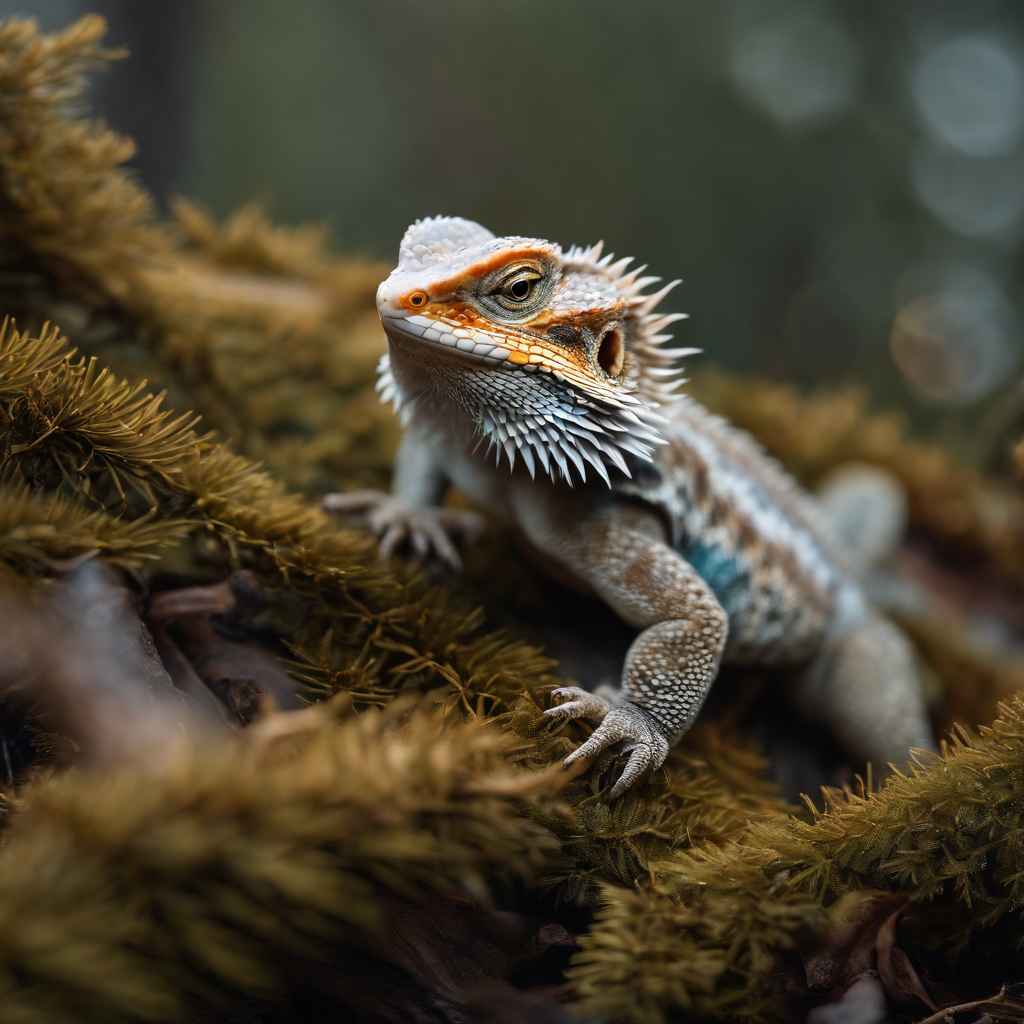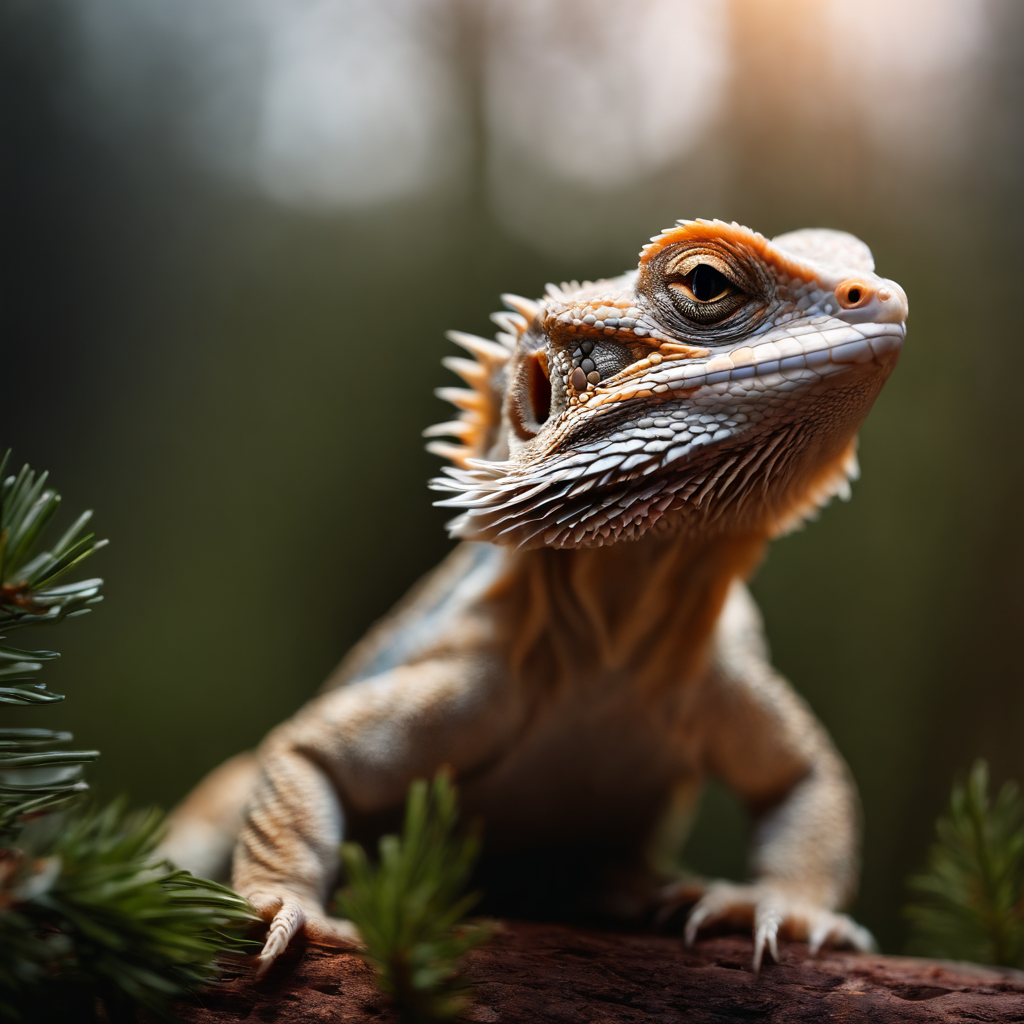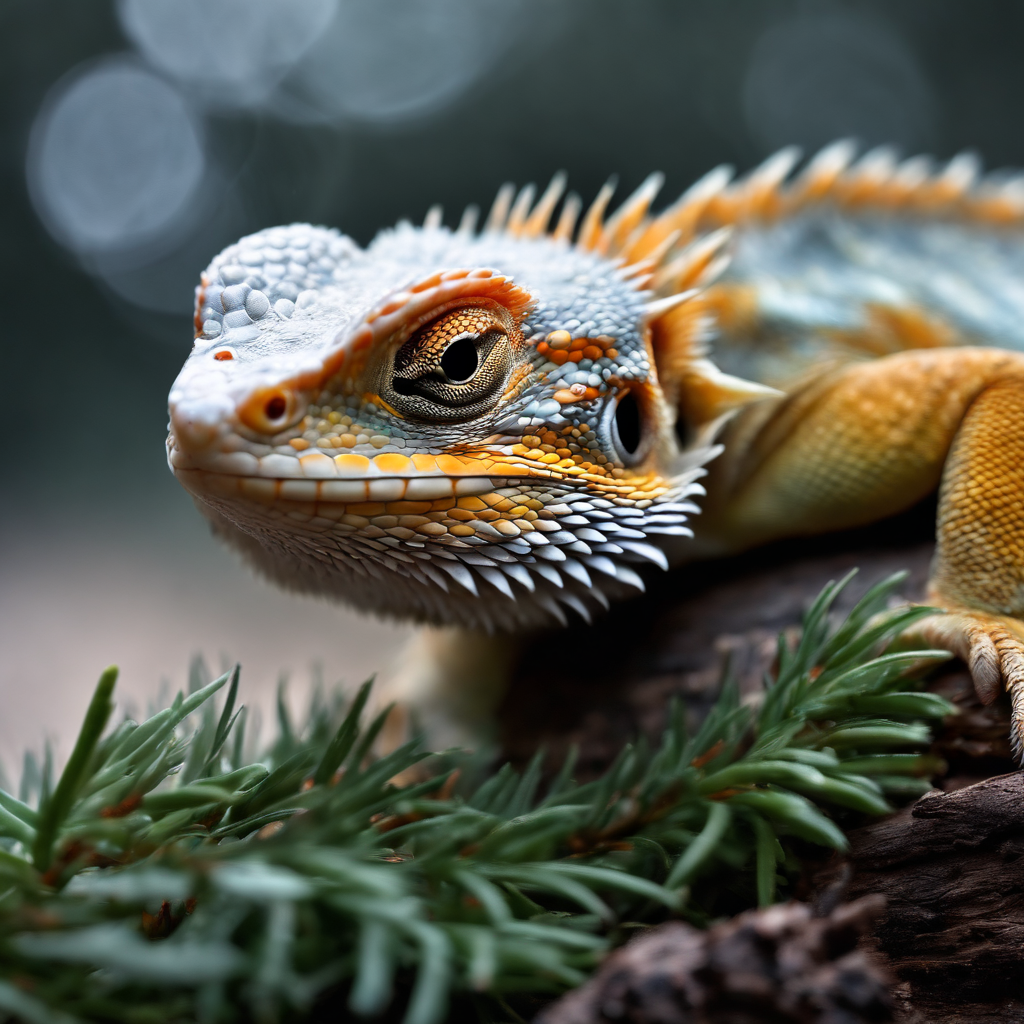Why Temperature is Important for Bearded Dragons’ Health

Maintaining the right temperature is crucial for the overall health and well-being of bearded dragons. These reptiles are ectothermic, which means they rely on external sources of heat to regulate their body temperature. Failure to provide them with suitable temperatures can lead to various health issues.
Firstly, proper temperature regulation is essential for a bearded dragon’s metabolism. They require specific temperatures to effectively digest their food and absorb nutrients. If the temperature falls below the optimal range, their metabolic rate decreases, leading to sluggish digestion and potential malnutrition. On the other hand, excessively high temperatures can also disrupt their metabolism and cause dehydration.
Furthermore, maintaining appropriate temperatures is vital for a bearded dragon’s respiratory health. Cold environments can lower their immune system function and make them more susceptible to respiratory infections such as pneumonia or bronchitis. By providing an adequately heated habitat, you ensure that your bearded dragon’s airways stay clear from mucus build-up and prevent any potential breathing difficulties.
In conclusion, it cannot be stressed enough how critical temperature regulation is for the well-being of bearded dragons. From supporting proper digestion and nutrient absorption to preventing respiratory issues, maintaining suitable temperatures in their habitat directly impacts their overall health. As responsible pet owners, it is our duty to create an environment that mimics their natural conditions by providing adequate heating elements such as basking spots or heat lamps while ensuring they have access to cooler areas within their enclosure as well
Understanding the Ideal Temperature Range for Bearded Dragons
Bearded dragons are ectothermic reptiles, meaning they rely on external heat sources to regulate their body temperature. Understanding the ideal temperature range for bearded dragons is crucial for maintaining their overall health and well-being.
The optimal temperature range for bearded dragons is between 95°F (35°C) and 105°F (40°C) during the day. This allows them to properly digest food, metabolize nutrients, and maintain a healthy metabolism. At night, the temperature can drop slightly to around 75°F (24°C) to mimic natural fluctuations in their environment.
It is important to provide a thermal gradient within your bearded dragon’s enclosure, with one side being warmer than the other. This allows them to move freely and choose the most comfortable spot based on their current needs. By offering a basking area with a heat source such as a heat lamp or ceramic heater, you ensure that they have access to the higher end of the temperature range when needed.
Maintaining an appropriate temperature range is essential for promoting proper digestion, metabolism, and overall physiological functions in bearded dragons. Failure to provide adequate temperatures can lead to digestive issues, decreased appetite, lethargy, weakened immune system response, and even hypothermia in severe cases. Therefore, it is vital for owners of these beloved reptiles to prioritize creating an optimal thermal environment within their enclosures
The Effects of Cold Temperatures on Bearded Dragons’ Metabolism
Cold temperatures can have a significant impact on the metabolism of bearded dragons. When exposed to cold temperatures, these reptiles experience a decrease in their metabolic rate. This means that their body processes slow down, including digestion and nutrient absorption. As a result, bearded dragons may struggle to properly break down food and extract the necessary nutrients from it.
Furthermore, cold temperatures can also lead to a decrease in appetite for bearded dragons. The drop in metabolic rate affects their hunger cues and reduces their desire to eat. This can result in weight loss and malnutrition if not addressed promptly.
In addition to affecting digestion and appetite, cold temperatures can also impact the overall energy levels of bearded dragons. They become lethargic and less active as their metabolism slows down. This lack of energy makes it difficult for them to engage in normal behaviors such as hunting or exploring their environment.
It is crucial for owners to provide appropriate heat sources and maintain an optimal temperature range for bearded dragons’ well-being. By ensuring they are kept warm enough, we can help support their metabolism, encourage proper digestion and nutrient absorption, stimulate appetite, and promote healthy activity levels in these fascinating reptiles.
Signs and Symptoms of Hypothermia in Bearded Dragons
Hypothermia in bearded dragons can have serious consequences on their health and well-being. It is important for reptile owners to be aware of the signs and symptoms of hypothermia so that they can take prompt action to prevent further complications. One common sign of hypothermia in bearded dragons is a decrease in activity levels. They may become lethargic, sluggish, and show little interest in their surroundings.
Another symptom of hypothermia is a change in coloration. Bearded dragons may appear paler or darker than usual when they are experiencing low body temperatures. Additionally, they may exhibit shivering or trembling as their bodies try to generate heat to compensate for the cold.
In severe cases of hypothermia, bearded dragons may experience difficulty breathing and reduced heart rate. Their limbs might become stiff or rigid, making it difficult for them to move properly. If left untreated, these symptoms can progress rapidly and lead to organ failure or even death. Therefore, it is crucial for owners to monitor their beardies closely and seek veterinary assistance if any signs of hypothermia are observed.
How Cold Temperatures Can Impact Bearded Dragons’ Digestive System
Bearded dragons rely on a properly functioning digestive system to break down and absorb nutrients from their food. However, exposure to cold temperatures can significantly impact the efficiency of their digestive processes. When bearded dragons are exposed to low temperatures, their metabolism slows down, leading to a decrease in appetite and digestion.
Cold temperatures can cause the muscles in the digestive tract of bearded dragons to contract and become less active. This reduced muscle activity hinders the movement of food through the gastrointestinal tract, resulting in slower digestion. As a result, undigested food may accumulate in the stomach or intestines, leading to discomfort and potential health issues such as constipation or impaction.
Furthermore, cold temperatures can also affect enzyme activity within the digestive system of bearded dragons. Enzymes play a crucial role in breaking down complex molecules into smaller compounds that can be absorbed by the body. In colder conditions, enzymatic reactions slow down or even cease altogether, impairing proper nutrient absorption. This deficiency may lead to malnutrition over time if not addressed promptly.
Inadequate digestion caused by exposure to cold temperatures can have severe consequences for bearded dragons’ overall health and well-being. It is essential for reptile owners to understand these risks and take appropriate measures to ensure that their pets are kept at optimal temperatures for proper digestion. By providing sufficient warmth through heating elements such as heat lamps or under-tank heaters, owners can help maintain an ideal temperature range that supports healthy digestion in their beloved bearded dragons without any compromise on their well-being
The Role of Heat Regulation in Bearded Dragons’ Respiratory Health
The respiratory health of bearded dragons is closely tied to their ability to regulate heat within their bodies. These reptiles are ectothermic, meaning they rely on external sources of heat to maintain their body temperature. Heat regulation plays a critical role in ensuring the proper functioning of their respiratory system.

One important aspect of heat regulation for bearded dragons is maintaining an optimal internal body temperature. When the ambient temperature drops below what is necessary for them to thermoregulate effectively, it can negatively impact their respiratory health. Cold temperatures can cause constriction and inflammation in the airways, making it difficult for these reptiles to breathe properly. This can lead to respiratory infections and other related issues.
Furthermore, adequate heat helps support the metabolic processes involved in respiration. Bearded dragons require warmth to facilitate efficient oxygen exchange and carbon dioxide elimination through their lungs. Insufficient heat can slow down these processes, compromising overall respiratory function. It is crucial for owners to provide appropriate heating elements such as basking spots or under-tank heaters that mimic natural thermal gradients found in the wild.
In conclusion, maintaining proper heat regulation is essential for promoting healthy respiratory function in bearded dragons. By providing suitable environmental conditions that allow them to achieve and maintain optimal body temperatures, owners can help prevent potential complications associated with cold exposure and ensure their pets’ well-being.
How Cold Temperatures Affect Bearded Dragons’ Immune System
Bearded dragons, like many reptiles, rely on their immune system to defend against pathogens and maintain overall health. However, exposure to cold temperatures can have a significant impact on the effectiveness of their immune response. When bearded dragons are subjected to low temperatures for extended periods, it can weaken their immune system and make them more susceptible to infections.
One way in which cold temperatures affect the immune system of bearded dragons is by reducing the production of white blood cells. These cells play a crucial role in fighting off bacteria, viruses, and other harmful microorganisms. In colder conditions, the production of white blood cells decreases, leaving these reptiles with a compromised defense mechanism.
Additionally, cold temperatures can also impair the functioning of certain components within the immune system. For example, cytokines are proteins that help regulate inflammation and coordinate immune responses. When bearded dragons experience prolonged exposure to low temperatures, the production and activity of cytokines may be disrupted or reduced. This disruption can hinder proper communication between different parts of the immune system and compromise its ability to mount an effective defense.
Furthermore, chronic exposure to cold temperatures can lead to chronic stress in bearded dragons. Stress has been shown to have negative effects on immunity in various species including reptiles. The release of stress hormones such as cortisol suppresses certain aspects of the immune response making it less efficient at combating infections or diseases.
In conclusion, the impact of cold temperatures on bearded dragons’ immune systems cannot be underestimated.
It weakens their defenses by reducing white blood cell production, impairing cytokine function and inducing chronic stress. These factors increase susceptibility to infections and compromise overall health. Therefore, maintaining appropriate temperature levels is essential for supporting optimal immunity in these fascinating creatures.
The Impact of Low Temperatures on Bearded Dragons’ Behavior and Activity Levels
Low temperatures can have a significant impact on the behavior and activity levels of bearded dragons. When exposed to cold temperatures, these reptiles may become lethargic and inactive. They may spend more time basking under their heat lamp or hiding in warm areas to conserve body heat. This decrease in activity is a natural response to the colder environment, as the metabolic processes slow down in order to preserve energy.
Additionally, low temperatures can affect the appetite of bearded dragons. In cooler conditions, their digestion slows down, making it harder for them to break down food properly. As a result, they may eat less or refuse food altogether. This reduced appetite can lead to weight loss and malnutrition if not addressed promptly.

Furthermore, cold temperatures can also impact the social behavior of bearded dragons. These reptiles are known for their curious and active nature when kept at optimal temperatures. However, when exposed to lower temperatures over an extended period of time, they may become more withdrawn and less interactive with their surroundings or owners.
It is crucial for bearded dragon owners to provide an appropriate temperature range within their enclosure to ensure healthy behavior and activity levels in these reptiles. By maintaining proper heating elements such as heat lamps or ceramic heaters along with temperature monitoring devices like thermometers or thermostats, owners can create a suitable environment that promotes normal behavioral patterns and overall well-being for their beloved pets
Potential Long-term Health Issues Caused by Chronic Cold Exposure in Bearded Dragons
Chronic cold exposure in bearded dragons can lead to a range of potential long-term health issues. One significant concern is the impact on their immune system. Bearded dragons rely on an optimal temperature range to maintain a strong immune response and fight off infections. Prolonged exposure to cold temperatures weakens their immune system, making them more susceptible to illnesses and diseases.
Another issue that arises from chronic cold exposure is the disruption of normal behavior and activity levels in bearded dragons. These reptiles are ectothermic, meaning they rely on external heat sources to regulate their body temperature. When exposed to cold for extended periods, bearded dragons may become lethargic and less active as their metabolism slows down. This decrease in activity can have negative effects on their overall health and well-being.
Furthermore, chronic cold exposure can result in digestive problems for bearded dragons. Cold temperatures hinder proper digestion by slowing down metabolic processes within the digestive system. This can lead to constipation or impaction, where undigested food builds up in the intestinal tract. Over time, these digestive issues can cause discomfort, malnutrition, and even life-threatening complications if left untreated.
It is crucial for owners of bearded dragons to understand the potential long-term health consequences of chronic cold exposure. By providing appropriate heating elements such as basking spots or heat lamps within their enclosure, owners can ensure that their beloved pets stay within the ideal temperature range necessary for maintaining good health and preventing these adverse effects caused by prolonged exposure to low temperatures
Preventing Hypothermia: Tips for Maintaining the Right Temperature for Your Bearded Dragon
To prevent hypothermia and ensure the well-being of your bearded dragon, it is crucial to maintain the right temperature in their habitat. Bearded dragons are ectothermic reptiles, meaning they rely on external heat sources to regulate their body temperature. Here are some tips to help you provide the optimal temperature for your pet:
Firstly, invest in a high-quality heat source such as a ceramic heat emitter or an under-tank heating pad. These devices should be placed at one end of the enclosure to create a thermal gradient. This allows your bearded dragon to move between warmer and cooler areas as needed.
Secondly, use a reliable thermometer to monitor the temperatures inside the enclosure accurately. The basking area should range from 95°F (35°C) to 105°F (40°C), while the cooler side should stay around 80°F (27°C) during the day and drop slightly at night.
Lastly, consider using additional heat sources like infrared bulbs or radiant panels if necessary, especially during colder months or in drafty environments. It’s essential not only to maintain proper temperatures but also avoid sudden fluctuations that can stress your bearded dragon.
By following these tips and regularly monitoring temperatures within your pet’s habitat, you can effectively prevent hypothermia and promote their overall health and well-being.
Conclusion
When a bearded dragon gets too cold, it can lead to a condition called brumation, which is a hibernation-like state that bearded dragons enter into, and is more common in the colder months1. During brumation, bearded dragons will sleep it off by making a burrow and wait until the warmer months again, living off their built-up internal nutritional reserves1. However, it is important to note that not all bearded dragons will go through brumation, and it is not necessary for them to do so1.
It is also important to note that bearded dragons are susceptible to respiratory infections, especially pneumonia, if they are kept in poor, cold, or dirty conditions3. Therefore, it is crucial to maintain proper temperature and cleanliness in their vivariums to prevent such infections.
To ensure that the bearded dragon’s vivarium is at an optimal temperature, it is recommended to keep the basking temperature between 38-42 degrees Celsius in the bright end of their vivarium and 22-26 degrees Celsius in the shaded end2. It is also recommended to provide a large, shallow water bowl that they can easily climb in and out of, which can serve as a summer soaking tub to cool down in if they so desire2. Additionally, creating a shaded, moist area for the bearded dragon to cool down in if needed can also be helpful2.
In conclusion, if a bearded dragon gets too cold, it can lead to brumation, a hibernation-like state that is more common in the colder months1. However, not all bearded dragons will go through brumation, and it is not necessary for them to do so1. It is important to maintain proper temperature and cleanliness in their vivariums to prevent respiratory infections, especially pneumonia3. Keeping the basking temperature between 38-42 degrees Celsius in the bright end of their vivarium and 22-26 degrees Celsius in the shaded end, providing a large, shallow water bowl, and creating a shaded, moist area for the bearded dragon to cool down in if needed can also be helpful2.
